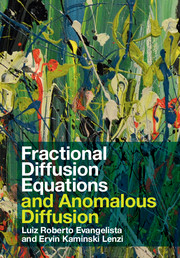Book contents
- Frontmatter
- Dedication
- Contents
- Preface
- 1 Mathematical Preliminaries
- 2 A Survey of Fractional Calculus
- 3 From Normal to Anomalous Diffusion
- 4 Fractional Diffusion Equations
- 5 Fractional Diffusion Equations
- 6 Fractional Nonlinear Diffusion Equations
- 7 Anomalous Diffusion
- 8 Fractional Schrödinger Equations
- 9 Anomalous Diffusion and Impedance Spectroscopy
- 10 The Poisson–Nernst–Planck Anomalous Models
- References
- Index
Preface
Published online by Cambridge University Press: 17 January 2018
- Frontmatter
- Dedication
- Contents
- Preface
- 1 Mathematical Preliminaries
- 2 A Survey of Fractional Calculus
- 3 From Normal to Anomalous Diffusion
- 4 Fractional Diffusion Equations
- 5 Fractional Diffusion Equations
- 6 Fractional Nonlinear Diffusion Equations
- 7 Anomalous Diffusion
- 8 Fractional Schrödinger Equations
- 9 Anomalous Diffusion and Impedance Spectroscopy
- 10 The Poisson–Nernst–Planck Anomalous Models
- References
- Index
Summary
The very irregular state of motion observed by Robert Brown for small pollen grains suspended in water initiated one of the the most fascinating fields of science. The importance of such discovery – the so-called diffusion process – is immeasurable; it has been found in many contexts and is widespread in nature. A characteristic feature of this random motion is the linear growth with time exhibited by the mean square displacement, which is typical of a Markovian process. In contrast with this situation, a large class of systems and processes present a diffusion behaviour characterised by a nonlinear time dependence of the same quantity, thus constituting what is called anomalous diffusion behaviour.
The last decades have witnessed an increased interest in the anomalous diffusion processes that seem to be indeed present in a variety of experimental scenarios in physics, chemistry, biology, and several other branches of engineering; it is a rapidly growing field of research, attracting the attention of the scientific community. This happens from the theoretical side – due to the new mathematical problems evoked – but also from the point of view of experimental or practical applications. It is noteworthy that the number of studies reporting experimental problems dealing with anomalous diffusion has strongly increased – this attests to the ubiquity of a phenomenon initially considered a rare event.
The power of the mathematical tools based on fractional calculus, on the other hand, has also attracted the attention of the community working with pure and applied mathematics. The association of these techniques with the diffusional problem represents in practice a new field of research. It was shown in several ways that fractional calculus, if it is not unique, is nevertheless a suitable or even the natural mathematical framework to use to face the high complexity represented by anomalous diffusion phenomena. One powerful way of using these mathematical tools to analyse diffusion processes leads naturally to the necessity to search for solutions of fractional linear and nonlinear diffusion equations.
- Type
- Chapter
- Information
- Fractional Diffusion Equations and Anomalous Diffusion , pp. ix - xivPublisher: Cambridge University PressPrint publication year: 2018



